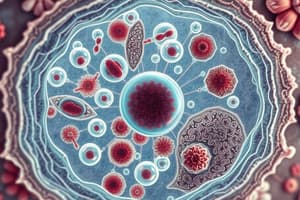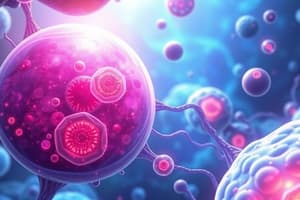Podcast
Questions and Answers
Which layer of the skin is composed of stratified squamous epithelium?
Which layer of the skin is composed of stratified squamous epithelium?
- Reticular layer
- Epidermis (correct)
- Subcutaneous layer
- Papillary layer
What type of connective tissue is found in the papillary layer of the dermis?
What type of connective tissue is found in the papillary layer of the dermis?
- Dense regular connective tissue
- Reticular connective tissue
- Areolar connective tissue (correct)
- Hyaline cartilage
What is another name for the subcutaneous layer?
What is another name for the subcutaneous layer?
- Stratum corneum
- Epidermis
- Hypodermis (correct)
- Dermal layer
Which of the following is NOT a component of the accessory structures associated with the skin?
Which of the following is NOT a component of the accessory structures associated with the skin?
Which type of cell is the primary component of the epidermis?
Which type of cell is the primary component of the epidermis?
Which layer of the dermis consists of dense irregular connective tissue?
Which layer of the dermis consists of dense irregular connective tissue?
What is the function of arrector pili muscles in the skin?
What is the function of arrector pili muscles in the skin?
What is the primary cause of malignant melanoma?
What is the primary cause of malignant melanoma?
Which statement about vitiligo is correct?
Which statement about vitiligo is correct?
Which of the following accurately describes age spots?
Which of the following accurately describes age spots?
What characteristic distinguishes atypical or dysplastic nevi?
What characteristic distinguishes atypical or dysplastic nevi?
What is true about basal cell carcinoma (BCC)?
What is true about basal cell carcinoma (BCC)?
What is the primary function of the stratum corneum?
What is the primary function of the stratum corneum?
Which process describes the replacement of cell contents with keratin in keratinocytes?
Which process describes the replacement of cell contents with keratin in keratinocytes?
What role do epidermal ridges play in the skin?
What role do epidermal ridges play in the skin?
Which of the following is a common characteristic of psoriasis?
Which of the following is a common characteristic of psoriasis?
What distinguishes corns from calluses?
What distinguishes corns from calluses?
Which cells are primarily responsible for creating the connective tissue in the dermis?
Which cells are primarily responsible for creating the connective tissue in the dermis?
What is the main purpose of the elastic fibers in the dermis?
What is the main purpose of the elastic fibers in the dermis?
How long does it typically take for keratinocytes to move from the deeper layers of the epidermis to the surface?
How long does it typically take for keratinocytes to move from the deeper layers of the epidermis to the surface?
What type of pigment is eumelanin?
What type of pigment is eumelanin?
What causes dandruff in relation to the keratinized cells of the scalp?
What causes dandruff in relation to the keratinized cells of the scalp?
What is the primary component of the dermis responsible for tissue strength?
What is the primary component of the dermis responsible for tissue strength?
Which pigment is primarily found in hair, freckles, lips, and nipples?
Which pigment is primarily found in hair, freckles, lips, and nipples?
What effect does increased blood flow have on skin color?
What effect does increased blood flow have on skin color?
Cyanosis is best described as what?
Cyanosis is best described as what?
Jaundice indicates what color change in the skin?
Jaundice indicates what color change in the skin?
Which condition is primarily characterized by the paleness of the skin?
Which condition is primarily characterized by the paleness of the skin?
What is the primary cause of albinism?
What is the primary cause of albinism?
What primary function do keratinocytes serve in the epidermis?
What primary function do keratinocytes serve in the epidermis?
What is the precursor of vitamin A mentioned in the content?
What is the precursor of vitamin A mentioned in the content?
What condition describes the skin's response to sustained reduction in blood flow?
What condition describes the skin's response to sustained reduction in blood flow?
Which statement about melanocytes is true?
Which statement about melanocytes is true?
What effect does beta carotene have beyond being a vitamin A precursor?
What effect does beta carotene have beyond being a vitamin A precursor?
How do Langerhans cells contribute to skin health?
How do Langerhans cells contribute to skin health?
What is the lifespan of cells in the stratum corneum before they are typically shed?
What is the lifespan of cells in the stratum corneum before they are typically shed?
Which epidermal cells are least numerous and are involved in touch sensation?
Which epidermal cells are least numerous and are involved in touch sensation?
From where are Langerhans cells derived?
From where are Langerhans cells derived?
What is the primary role of lamellar granules produced by keratinocytes?
What is the primary role of lamellar granules produced by keratinocytes?
Why do cells with the highest metabolic demand reside closest to the dermis?
Why do cells with the highest metabolic demand reside closest to the dermis?
Which epidermal layer lacks blood vessels?
Which epidermal layer lacks blood vessels?
Flashcards
Epidermis
Epidermis
The superficial, thinner layer of the cutaneous membrane, composed of stratified squamous epithelium. It is avascular.
Stratified Squamous Epithelium
Stratified Squamous Epithelium
The type of tissue that makes up the epidermis, consisting of multiple layers of flattened cells.
Keratinocytes
Keratinocytes
The primary cell type in the epidermis, producing keratin.
Subcutaneous Layer
Subcutaneous Layer
Signup and view all the flashcards
Avascular
Avascular
Signup and view all the flashcards
Papillary Layer
Papillary Layer
Signup and view all the flashcards
Reticular Layer
Reticular Layer
Signup and view all the flashcards
Vitiligo
Vitiligo
Signup and view all the flashcards
Melanoma
Melanoma
Signup and view all the flashcards
Basal Cell Carcinoma
Basal Cell Carcinoma
Signup and view all the flashcards
Age Spot
Age Spot
Signup and view all the flashcards
Hair Follicle
Hair Follicle
Signup and view all the flashcards
Melanocytes
Melanocytes
Signup and view all the flashcards
Langerhans cells
Langerhans cells
Signup and view all the flashcards
Tactile epithelial cells (Merkel cells)
Tactile epithelial cells (Merkel cells)
Signup and view all the flashcards
Melanin Transfer
Melanin Transfer
Signup and view all the flashcards
Epidermal Layers
Epidermal Layers
Signup and view all the flashcards
Stratum Corneum
Stratum Corneum
Signup and view all the flashcards
Epidermal Cell Nourishment
Epidermal Cell Nourishment
Signup and view all the flashcards
Cell Turnover Time
Cell Turnover Time
Signup and view all the flashcards
Eumelanin
Eumelanin
Signup and view all the flashcards
Pheomelanin
Pheomelanin
Signup and view all the flashcards
Carotene
Carotene
Signup and view all the flashcards
Erythema
Erythema
Signup and view all the flashcards
Cyanosis
Cyanosis
Signup and view all the flashcards
Pallor
Pallor
Signup and view all the flashcards
Jaundice
Jaundice
Signup and view all the flashcards
Albinism
Albinism
Signup and view all the flashcards
Hemoglobin
Hemoglobin
Signup and view all the flashcards
Skin color
Skin color
Signup and view all the flashcards
Epidermal Keratinization
Epidermal Keratinization
Signup and view all the flashcards
Epidermal Ridges
Epidermal Ridges
Signup and view all the flashcards
Fingerprints
Fingerprints
Signup and view all the flashcards
Dandruff
Dandruff
Signup and view all the flashcards
Psoriasis
Psoriasis
Signup and view all the flashcards
Calluses
Calluses
Signup and view all the flashcards
Corns
Corns
Signup and view all the flashcards
Dermis Overview
Dermis Overview
Signup and view all the flashcards
Fibers of Dermis
Fibers of Dermis
Signup and view all the flashcards
Study Notes
Cell Structure and Function
- Various cell organelles and their roles are depicted, likely in a diagrammatic format.
- Specific locations of organelles within the cell are shown.
- Different cellular processes, possibly including protein synthesis, are likely represented.
- The functions of different cellular components and their interactions are detailed.
- Diagrammatic representation of cell components are likely present.
Studying That Suits You
Use AI to generate personalized quizzes and flashcards to suit your learning preferences.




